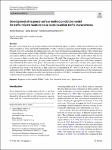Item Infomation
Full metadata record
| DC Field | Value | Language |
|---|---|---|
| dc.contributor.author | Elkafoury, Ahmed | - |
| dc.contributor.author | Elboshy, Bahaa | - |
| dc.contributor.author | Darwish, Ahmed Mahmoud | - |
| dc.date.accessioned | 2023-08-04T09:20:44Z | - |
| dc.date.available | 2023-08-04T09:20:44Z | - |
| dc.date.issued | 2023 | - |
| dc.identifier.uri | https://link.springer.com/article/10.1007/s11356-023-28934-7 | - |
| dc.identifier.uri | https://dlib.phenikaa-uni.edu.vn/handle/PNK/8697 | - |
| dc.description | CC-BY | vi |
| dc.description.abstract | Recently, several urban areas are trying to mitigate the environmental impacts of traffic, where noise pollution is one of the main consequences. Thus, studying the determinants of traffic-related noise generation and developing a model that predicts the level of noise by controlling the influencing factors are crucial for transportation planning purposes. This research aims at utilizing the response surface method (RSM) to develop a robust statistical prediction model of traffic-related noise levels and optimize different traffic characteristics’ ranges to reduce the expected noise levels. The results indicate that the rate of Leq increase is higher at traffic flow values less than the 1204 veh/h. The interaction effect of flow-speed and flow-heavy vehicle percentage pairs shows that Leq has peak values around 45.8 km/h and 28.71%, respectively, with almost symmetric value distribution about those center points. | vi |
| dc.language.iso | en | vi |
| dc.publisher | Springer | vi |
| dc.subject | traffic-related roadside noise | vi |
| dc.subject | response surface method | vi |
| dc.title | Development of response surface method prediction model for traffic-related roadside noise levels based on traffic characteristics | vi |
| dc.type | Book | vi |
| Appears in Collections | ||
| OER - Khoa học môi trường | ||
Files in This Item:

